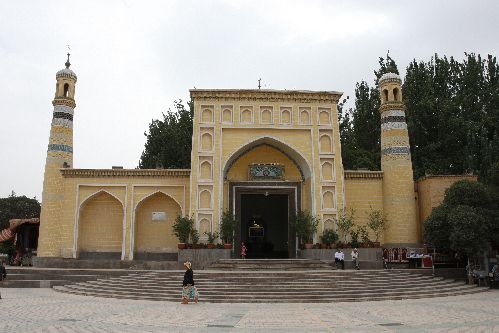
The front entrance to Id Kah Mosque, Kashgar's largest place of worship (ZOU YI)
With its well-preserved ethnic culture, Xinjiang, the most western region in China, is drawing the eyes of the world
Many visitors to Kashgar, the westernmost city in northwest China's Xinjiang Uygur Autonomous Region, may well be lured by a widespread saying that "you'll not know the true face of Xinjiang if you don't go to Kashgar."
With Uygur people accounting for around 90 percent of its population, the oasis city west of the Taklamakan Desert is called a living museum of Uygur culture owing to its preservation of ethnic lifestyles amid modern trappings.
The scene that initially meets one in Kashgar certainly holds the imagination hostage—women, sporting colorful headscarves and Uygur-style long skirts in bright colors, ride motorbikes along city streets and even roads in suburban areas. It gives one a strong sense of the merging of tradition and modern life.
The whole city of Kashgar is divided roughly into two parts, the old town and a new developmental zone. Now the latter has been accorded the status of special economic development zone, the only one of its kind in west China and established with the intent of upgrading the local economy through modernization of industry. The ancient part of the city, meanwhile, is subject to protections designed to keep the living environment of Uygur people in the region intact.
Maintaining tradition
With a history of more than 2,000 years, the old town of Kashgar is acknowledged as being the homeland of the Uygur people in China. In history, Kashgar was the largest city in south Xinjiang. It was a transportation hub on the ancient Silk Road, a network of trade routes linking the East and the West, and a center of trading for Eurasian countries owing to its geographic advantages. Today, it stands as a monument to the authentic culture and life of Chinese Muslims.
The old town is one of the largest remaining earthen construction sites in the world. Covering 8 square km, it is home to a population of over 220,000.
Since 2009, the local government has carried out a project to renovate old buildings in the area based on the principle that maintaining the original facade of the houses while modernizing the facilities contained within, which will improve living conditions for people inhabiting the area.
According to Anwar Tursun, Mayor of Kashgar, all of the houses in the old town were originally built with raw soil and wood, and were not secure enough to withstand earthquakes. There was also a lack of public infrastructural facilities such as fire escapes, water pipelines and sewage systems in the area, making life inconvenient for residents.
"Post renovation, all of the buildings have preserved the architectural style of the Uygur ethnic group while being modernized within, continuing the folk culture and providing people with a cleaner environment," said the mayor.
Through renovation, the local government hopes to attract more tourists to the ancient city and to create more job opportunities for local people, granting them a higher income and a better life, he said.
In July, Kashgar's old town was ranked among China's national-level five-star scenic sites, a development that is expected to draw more tourists here.
Wandering the streets of the old town, visitors will find it difficult to pry their camera lens away from the unique Uygur-style decorations on the buildings, beautiful Uygur women in traditional dresses made from Ide Rice silk and various local snack stands touting delicacies such as naan, a kind of crusty pancake that represents the staple food archiof the Uygur people, and zhuafan, a type of fried rice. A network of tiny lanes house shops trading in folk handicraft products, such as traditional handmade Uygur hats, metal work, pottery, musical instruments and flowerpots.


















































